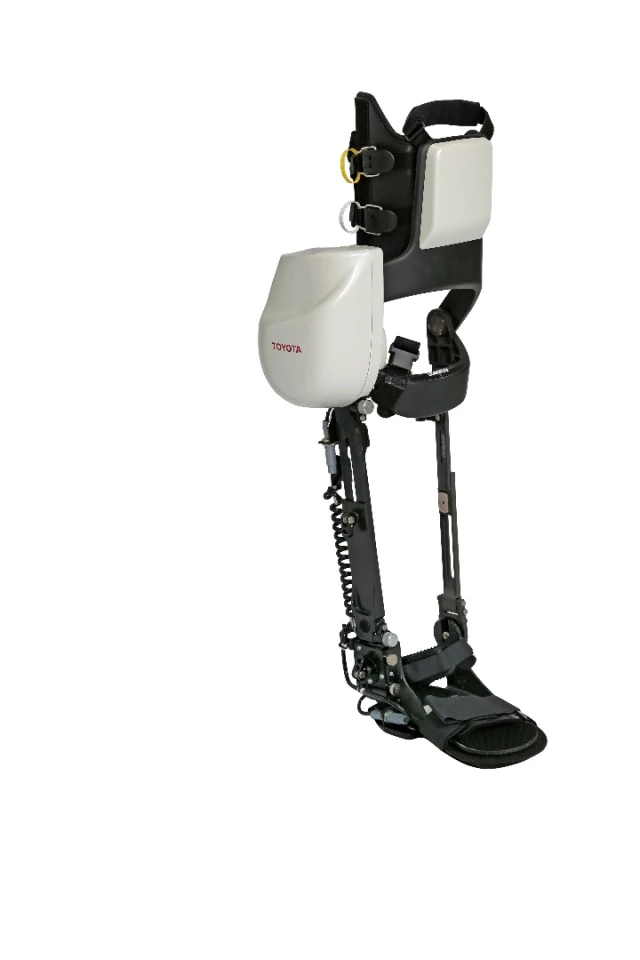Stepping out of your comfort zone isn't easy, but when you're a Japanese carmaker faced with an aging population that needs more help getting back on their feet than behind the wheel, that's what you do. For the past decade, Toyota has been working on a robotic rehabilitation system to help those with lower-limb paralysis regain the use of their legs and has now begun to rent the system under the name, Welwalk WW-1000.
Comprising a robotic brace and a main interface that includes a monitor and treadmill, the Welwalk is designed to address the problems faced by patients using braces in conventional walk rehabilitation programs. For example, a long leg brace might be able to support its wearer's body weight but makes moving the legs difficult due to the way the knees are strapped up. A short brace, on the other hand, offers greater mobility but also a higher risk of the knees giving way due to the lack of support around the area.
With the Welwalk system, patients strap the robotic brace onto the thigh, knee and ankle of the paralyzed leg before they begin their session on the customized treadmill. A harness supports their body from above while sensors in the robotic brace monitor their movements, adjusting the level of assistance provided by the motor components, such as helping patients bend and extend their knee, as they advance through the program.

Other support functions include providing audio feedback to users, such as warning them when their knees are about to give way; allowing users to observe their gait on the monitor; and updating therapists and physicians on the patient's progress with data compiled from the sessions.
Another key feature of the system is that it provides "just barely enough" support so that patients do not slow down their rehabilitation by becoming overly reliant on the machine. According to professor Eiichi Saitoh of Fujita Health University, who worked with Toyota to develop the rehabilitation robot, the system is more precise than a human therapist and helps patients walk 1.6 times sooner than conventional rehabilitation programs.

Ten years in the making, Toyota intends to start renting the system to medical institutions in Japan this fall, beginning with 100 units. Those who sign on pay a one-time up-front charge of 1 million yen (US$9,149), followed by a monthly fee of 350,000 yen (US$3,202). The long-term goal is to rent it to all 1,500 rehabilitation centers in the country. There's no word yet on when it will be made available overseas.
While this is not Toyota's first foray into the robotics industry – it was already developing industrial robots for its manufacturing plants in the 1980s – the Welwalk is just one example of how the company is looking beyond the automobile industry to what it calls "partner robots" to keep abreast of the growing needs of Japan's greying population. Other developments in the works include robots that help care givers lift patients and provide companionship to the elderly.
Despite all that has been said about the threat robots pose to jobs, in a country with a dwindling working population and a low fertility rate, the machines offer a respite from the strain imposed by the demands of a growing demographic with fewer people to take care of them. According to official forecasts, to support its elderly, Japan will need at least a million more professional care workers by 2025. At present, those aged 65 or older make up nearly 27 percent of the country's 127 million population, making it the highest percentge ever recorded. With the nation's baby boomers entering this age bracket, this figure is predicted to increase to 40 percent by 2060. The global average, on the other hand, currently hovers at around 8.3 percent.
That said, Toyota is not the only automobile manufacturer that has set its sights on helping the elderly and those with mobility issues. It joins Honda, which started leasing its Walking Assist Devices to Japanese hospitals two years ago, and South Korean company Hyundai, which has been working on a series of mobility exoskeletons targeted at a range of different markets. Elsewhere in the world, the robotic mobility aids sector has been growing steadily, as we've documented in the past, with companies such as ReWalk Robotics and suitX, as well as various research institutions getting in on the action.
Watch how the system works in the video below.
Source: Toyota







